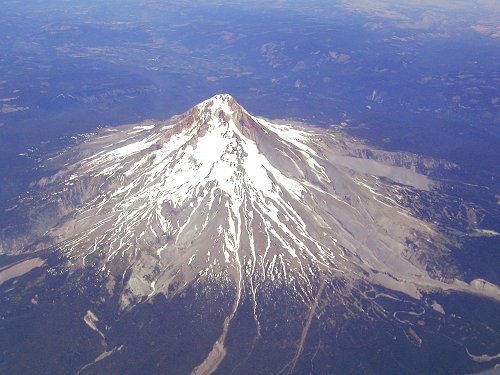Looking Down from the Sky
Today, we look upon Earth from above. The University of Houston's College of Engineering presents this series about the machines that make our civilization run, and the people whose ingenuity created them.
I'm just back from one more airplane trip -- one more chance to see Earth from above. That adventure has been tarnished by familiarity and by high altitude. But, this time I paid closer attention while we were still climbing beneath the clouds.
Such views were the great miracle of the late nineteenth century, and we began capturing them in two ways. Inspired by balloonists, skillful itinerant artists, with a strong command of perspective, went from town to town. They made detailed bird's eye view drawings of each hamlet, as it would've appeared from above.
When photography became fast enough to get a sharp photo from a balloon, cameras were destined to overtake artists. By the 1930s, aerial photography was now routinely being done from airplanes.
Two of the many people who talked about the new aerial perspective were Charles Lindbergh and the radical architect Le Corbusier. For Le Corbusier, the view from above made the earth below into an abstraction. In 1935, he wrote.
The bird's eye view ... now sees in substance what the mind formerly could only subjectively conceive.
He particularly disliked what he saw of cities from above. He went on to make this chilling remark:
Cities must be extricated from their misery, come what may. Whole quarters of them must be destroyed and new cities built.
Then we see the sterile geometrical city layouts he proposed as replacements. Just as Mussolini and Hitler took power, Le Corbusier was gravitating into a like-minded form of technocratic fascism.
The young Lindbergh was also accused of pro-fascist leanings. However, at the end of long and complex life, he was still struggling to get it right. In his last book, published after he died, he recalls visiting an island off the Brittany coast, in 1938. First, he seems to echo Le Corbusier. He says:
... when I was flying from America to Europe [I] looked down on the Atlantic and wondered what shapes and contours were masked by the sameness of its surface. ... the sea maintained its dignified aloofness.
But now, walking the beach below, his tone changes:
At the edge of [the sea], each fastly ebbing tide opened the ocean's threshold, let you step into a strange and foreign realm. Fish, camouflaged by weeds, hung motionless in crystal pools. Green, protoplasmic masses lay inertly on the stones. A tentacle from a small squid flashed out.
Lindbergh had been a barnstormer, a hero, an inventor, and a WW-II combat pilot. He'd had seen it all from above. An older Lindbergh understands how that elevated perspective can deceive any of us.
We engineers live by abstracting reality into manageable parcels. But we know nothing if we disconnect from the hard earth of messy detail. The "dignified aloofness" of the long view is lovely, but only because it is constructed from the rich organic clutter contained within it.
I'm John Lienhard, at the University of Houston, where we're interested in the way inventive minds work.
(Theme music)
For more on LeCorbusier and fascism, see: C. Jenks, Le Corbusier and the Continual Revolution in Architecture. New York: The Monacelli Press, 2000.
Le Corbusier, Aircraft. New York: Universe Books, 1988 (reprint of a 1935 English edition.)
For more on Le Corbusier and his ideas see F. Choay, Le Corbusier. New York: George Braziller, Inc., 1960; and G. H. Baker, Le Corbusier: An Analysis of Form. Hong Kong: Van Nostrand Reinhold (U.K.) Co. Ltd., 1984.
C. A. Lindbergh, Autobiography of Values. New York: Harcourt Brace Jovanovich, 1976, pp. 366-367.
L. S. Reich, From the Spirit of St. Louis to the SST: Charles Lindbergh, Technology, and Environment. Technology and Culture, April 1995, Vol. 36, No. 2, pp. 351-393.

View Mt. Hood from above, and it becomes an altered reality